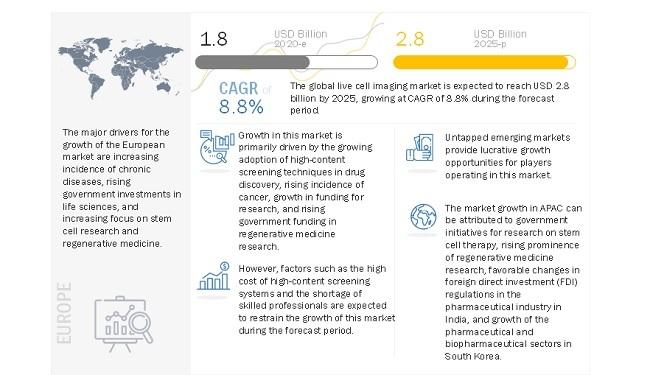
The Future of growing adoption of high-content screening techniques in drug discovery and rising incidence of cancer primarily drives the market for live cell imaging. The growth in research funding and rising government funding and investment in regenerative medicine research will also support the market growth in the coming years. However, the high cost of high-content screening systems is limiting the overall adoption of these products.
The COVID-19 pandemic has resulted in a tremendous increase in the burden on healthcare organizations across the globe. According to the WHO, as of September 29, 2020, there were 33,249,563 confirmed cases of COVID-19, including 1,000,040 deaths, with the highest number of deaths in the Americas, followed by Europe and Southeast Asia.
The normalization of the global economy will slowly increase the demand for live cell imaging systems in non-COVID-related research activity labs, leading to market growth from the first quarter of 2021. Furthermore, players operating in the market are altering their strategies, for both long-term and short-term growth, by tapping the research market and developing innovative products to combat the pandemic.
Download PDF Brochure @ https://www.marketsandmarkets.com/pdfdownloadNew.asp?id=163914483
The traditional method of toxicity and drug safety studies involves the screening of large libraries through high-throughput screening. This method is expensive, has a low success rate, and is resource- and time-consuming.

The use of HCS makes the drug development process more time- and cost-efficient. Owing to these factors, the adoption of high-content screening for toxicity studies is expected to increase during the forecast period. This, in turn, is expected to drive market growth as live cell imaging is used in HCS to identify meaningful information from complex systems such as in vitro, in vivo, and ex vivo systems.
High-content screening (HCS) instruments are equipped with advanced features and functionalities and are, therefore, priced at a premium. A confocal microscope, for instance, can cost more than USD 250,000, and a wide-field microscope can cost more than USD 100,000. Similarly, the InCell 2000 Analyzer system (from GE Healthcare) used in HCS costs around USD 240,000.
Academic research laboratories find it difficult to afford such high-priced instruments as they have restricted budgets. The high price of these instruments is also a concern for several pharmaceutical companies as they require multiple HCS systems in their R&D activities (thus increasing the total cost spent on these systems).
The high growth rate of this region can mainly be attributed to the factors such as the government initiatives for research on stem cell therapy, the rising prominence of regenerative medicine research, growth of preclinical/clinical research in China, favorable changes in foreign direct investment (FDI) regulations in the pharmaceutical industry in India, and growth of the pharmaceutical and biopharmaceutical sectors in South Korea.
For Any Query or Customization need to add in “Live Cell Imaging - Overview” Kindly Follow this URL: https://www.marketsandmarkets.com/requestCustomizationNew.asp?id=163914483




























